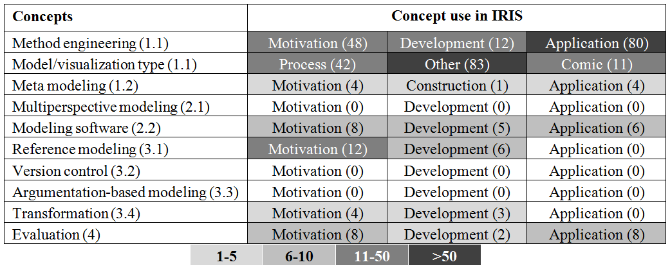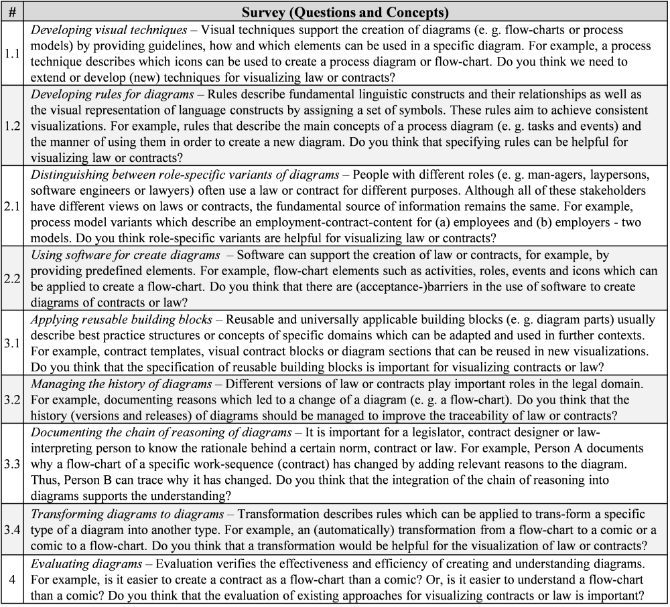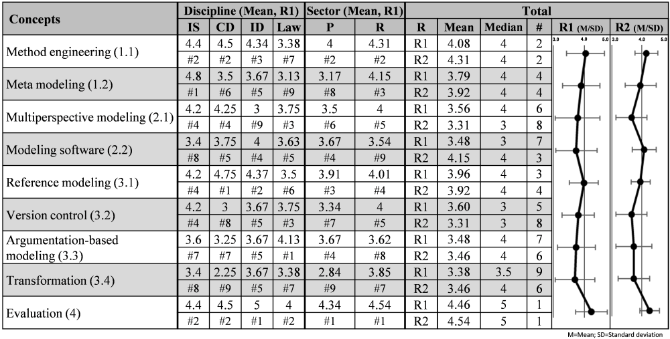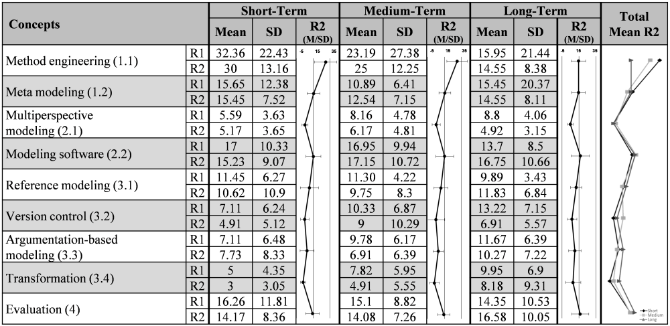1.
Introduction ^
2.
Research Method ^
Literature review. To identify and classify the status quo of modeling and visualization in law we conducted a literature review. An important factor is the rigor of the search process. Therefore, researchers have to document findings, the selection of keywords and the evaluation of the results. Due to the methodological rigor of literature reviews, we followed [vom Brocke/et al. 2009]: definition of review scope (section 1), conceptualization of topic (section 3.1), literature search, analysis and synthesis (section 4.1.).
3.1.
Conceptualization ^
3.2.
Analysis und Synthesis ^
4.1.
Study Settings ^
4.2.
Analysis and Results ^
- Sector: Research and science (46.12%); Practice (38.46%); other (7.69%).
- Discipline: Information Systems (15.38%); Information Design (11.54%); Contract Design (15.38%); Law (26.92%); Other (23.08%) (e.g. knowledge management or engineering).
- Work Experience: <=1 (7.69%); 1–3 (3.85%); 4–7 (11.54%); 8–10 (3.85%); >=11 (65.38%).
Rankings. In Figure 3, the results from round 1 (R1) and round 2 (R2) are presented. We distinguished: (I) discipline – Information Systems (IS) (n=5), Contract Design (CD) (n=4), Information Design (ID) (n=3) and Law/Jurisprudence (n=8); (II) sector – (P) (n=12) and research (R) (n=13); (III) total.
Best ranked concepts (short-term). The best ranked concept by far, in both rounds, was method engineering (1.1) (mean=32.36; 30). After that, modeling software (2.2), evaluation (4) and meta modeling (1.2) were approximately the same. Evaluation and modeling software were reduced in round 2.
Best ranked concepts (long-term). The long-term ratings were more balanced. The best ranked concepts were modeling software (2.2) evaluation (4), method engineering (1.1) and meta modeling (1.2), followed by reference modeling (3.1) (R2=11.83) and argumentation-based modeling (3.3) (R2=10.27).
Standard deviation (SD). Although meta modeling (1.2) and evaluation (4) had higher means, they also had low SDs which indicates that the answers were more consolidated.
- Visualization: «[…] contract element and various visual tools»; «define interfaces – (…) techniques with the aid of legal modeling language»; using «multimedia»
- Evaluation: «How do we make sure that explanatory pictures, text (human readable) and computer code (machine readable) all say the same thing?»; «integrate visual into computer code»; «a computer program (…) be able to interpret the modelled rules? (…) interpretability of the same (…) for machines.»
- Tools: «[…] to create a visualization should have more tools available.»; «[…] devices used for the generation and visualization […] (e.g. Google Glasses)»
- User Centred Design: «[…] developing them together with the users (…) studying how the users feel.»
- Standards vs. No-Standards: «[…] visualization of contracts is most important – establish a standard and then the rest can be implemented subsequently»; «Standard clauses and symbols»; «Conceptualizing contracts as data.»; «The use of open, not standardized visualization like sketching.»
- Role-specific understanding: «[…] specifically cultural differences in understanding.»
- Modeling techniques: «Mind maps […]»; «Interactive Flowcharts may create more accurate depictions»
- Design literacy: «Visual is not intrinsically better than text. So it is important that the creators of tools as well as the users (…) still know what they are doing.»
5.1.
Research Agenda ^
Connecting disciplines. Due to the fact that visualizing law or contracts is an interdisciplinary field, a common ground for the disciplines involved should be provided. However, the implementation and the analysis of our study indicate some issues which need further research, for example, (a) inconsistent understandings of concepts, (b) partly inconsistent wording of concepts (e.g. diagram vs. conceptual model) and (c) heterogeneous assessments of relevance, especially by legal experts (Figure 3). So, joint projects would be helpful.
5.2.
Limitations ^
The Delphi study assumes that experts are able to provide knowledge for future trends. The selection of experts and the derived trends are based on interpretations, decisions and methods which have limitations. Moreover, some experts participated only in the first round which impacts the analysis. The literature review is limited to IRIS proceedings. The selection of keywords and evaluation criteria is based on own decisions. We initially focused on the identified concepts (see 3.1) – other aspects could be analyzed too, for example, model analysis to prevent defective law design or to ensure legal compliance (e.g. [Delfmann et al. 2009]).
6.
References ^
Berger-Walliser, Gerlinde/Barton, Thomas D./Haapio, Helena, From visualization to legal design: A collaborative and creative process. In: American Business Law Journal, Vol. 54(2), https://ssrn.com/abstract=2841030, 2017.
Brocke, Jan vom/Simons, Alexander/Niehaves, Bjoern/Reimer, kai/Plattfaut, Ralf/Cleven, Anne, Reconstruction the Giant: On the Importance of Rigour in Documenting the Literature Search Process. In: Proceedings of the European Conference on Information Systems (ECIS) 2009, pp. 2206–2217.
Brüggemeier, Martin/Dovifat, Angela, Referenzmodelle für die Leistungserstellung in öffentlichen Leistungsnetzwerken. In: Schweighofer, Erich/Liebwald, Doris/Augeneder, Silvia (Eds.), Effizienz von e-Lösungen in Staat und Gesellschaft, Tagungsband des 8. Internationalen Rechtsinformatik Symposions IRIS 2005, Boorberg, 2005, pp. 211–214.
Brunschwig, Colette, Legal Design und Web Based Legal Training. In: Schweighofer, Erich/Menzel, Thomas/Kreuzbauer, Günther (Eds.), IT in Recht und Staat, Schriftenreihe Rechtsinformatik, Verl. Österreich Wien 2002, pp. 297–308.
Conboy, Kevin, Diagramming Transactions: Some Modest Proposals and a Few Suggested Rules. In: Transactions: Tennessee Journal of Business Law, Vol. 16, pp. 91, 2014.
Curtotti, Michael Angelo, Enhancing the Communication of Law: a cross-disciplinary investigation applying information technology, thesis of the Australian National University, 2016
Delbecq, Andre L./Van de Ven, Andrew H./Gustafson, David H., Group techniques for program planning: A guide to nominal group and Delphi processes. Scott Foresman, 1975.
Delfmann, Patrick/Herwig, Sebastian/Lis, Lukas/Stein, Armin, Supporting Distributed Conceptual Modelling through Naming Conventions. In: Enterprise Modelling and Information Systems Architectures, (4)1, pp. 3–20.
Fill, Hans-Georg/ Haiden, Katharina, Visuelle Modellierung für Rechtsberatende Berufe am Beispiel der gesetzlichen Erbfolge. In: Schweighofer, Erich/Kummer, Franz/Hötzendorfer, Walter/Borges, Georg (Eds.), Netzwerke, Tagungsband des 19. Internationalen Rechtsinformatik Symposions IRIS 2016, books@ocg.at, Wien 2016, pp. 349–356.
Haapio, Helena/Hagan, Margaret, Design Patterns for Contracts. In: Schweighofer, Erich/Kummer, Franz/Hötzendorfer, Walter/Borges, Georg (Eds.), Netzwerke, Tagungsband des 19. Internationalen Rechtsinformatik Symposions IRIS 2016, books@ocg.at, Wien 2016, pp. 381–386.
Heddier, Marcel/Knackstedt, Ralf, Empirische Evaluation von Rechtsvisualisierungen am Beispiel von Handyverträgen. In: Schweighofer, Erich/Kummer, Franz/Hötzendorfer, Walter (Eds.), Abstraktion und Applikation, Tagungsband des 16. Internationalen Rechtsinformatik Symposions IRIS 2013, books@ocg.at, Wien 2013, pp. 413–420.
Hevner, Alan R./March, Salvatore T./Park, Jinsoo/Ram, Sudha, Design science in information systems research. In: Management Information Systems Quarterly (MISQ), Vol. 28(1), 2004, pp. 75–105.
Izumo, Takashi, Die Anwendbarkeit von Ontologie-Editor HOZO auf die Rechtswissenschaft. In: Schweighofer, Erich/Kummer, Franz/Hötzendorfer, Walter (Eds.), Abstraktion und Applikation, Tagungsband des 16. Internationalen Rechtsinformatik Symposions IRIS 2013, books@ocg.at, Wien 2013, pp. 365–370.
Kahlig, Wolfgang, Visualisierungstypologie des Deutschen Privatrechts. In: Schweighofer, Erich/Kummer, Franz (Eds.), Europäische Projektkultur als Beitrag zur Rationalisierung des Rechts, Tagungsband des 14. Internationalen Rechtsinformatik Symposions IRIS 2011, books@ocg.at, Wien 2011, pp. 575–584.
Knackstedt, Ralf/Heddier, Marcel/Becker, Jörg, Conceptual Modeling in Law: An Interdisciplinary Research Agenda. In: Communications of the AIS (CAIS), 34(1), 2014.
Kung, C. H./Solvberg, Arne, Activity Modeling and Behaviour Modeling. In: Proceedings of the IFIP WG8.1 working conference on Information system design methodologies, North-Holland Publishing Co., 1986, pp. 145–171.
Niemand, Sven/Speck, Andreas, Prozess-Muster für den Entwurf von Rechtsnorm-basierten Prozessdiagrammen. In: Schweighofer, Erich/Kummer, Franz/Hötzendorfer, Walter/Borges, Georg (Eds.), Netzwerke, Tagungsband des 19. Internationalen Rechtsinformatik Symposions IRIS 2016, books@ocg.at, Wien 2016, pp. 595–602.
Sauerwald, Markus, Mind Mapping als Visualisierungsmethode in der juristischen Praxis. In: Schweighofer, Erich/Geist, Anton/Heindl, Gisela (Eds.), 10 Jahre IRIS: Bilanz und Ausblick, Tagungsband des 10. Internationalen Rechtsinformatik Symposions IRIS 2007, Boorberg, 2007, pp. 480–485.
Schalles, Christian, Usability evaluation of modeling languages, Gabler Verlag, Wiesbaden 2013.
Walser Kessel, Caroline, Rechtsvisualisierung im Spannungsfeld zwischen Abstraktion und Applikation – Am Beispiel des neuen schweizerischen Kindes- und Erwachsenenschutzrechts. In: Schweighofer, Erich/Kummer, Franz/Hötzendorfer, Walter (Eds.), Abstraktion und Applikation, Tagungsband des 16. Internationalen Rechtsinformatik Symposions IRIS 2013, books@ocg.at, Wien 2013, pp. 403–412.










